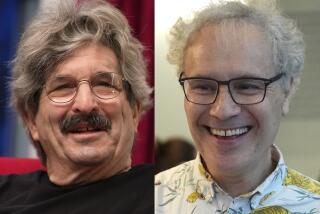Aage Bohr dies at 97; Danish physicist and Nobel Prize winner
Aage Bohr, the Danish theoretical physicist whose explanation for the shape of the atomic nucleus won him a share of the 1975 Nobel Prize in physics, died Sept. 8 in Copenhagen. He was 87.
Bohr was part of an even more elite group, one of only seven parent-child combos to have each won a Nobel. His father, Niels, won the physics Nobel in 1922, shortly after young Aage was born. Aage also served as his father’s secretary, traveling companion and assistant during the Manhattan Project, the World War II effort to build an atomic bomb.
By the end of the 1940s, the conventional view of the atomic nucleus as a sphere with neutrons evenly dispersed throughout was being cast into doubt by experimental evidence suggesting that it was ovoid in shape. Niels Bohr had won his prize, in part, for suggesting that nuclear components are arranged in a sphere like molecules in a drop of water.
Working independently but consulting frequently, James Rainwater of Columbia University and a newly graduated Aage Bohr, who was at Columbia on a fellowship, concluded that, in simplest terms, centrifugal forces from the nucleus’ revolution caused it to bulge outward at the center. Rainwater published a paper on the topic in April 1950 and Bohr a more generalized paper a month later.
Returning to Denmark, Bohr joined with Ben Mottelson, a naturalized Dane, to further refine the idea, producing a theory that could be verified by experiments. Working together over the next 25 years, Bohr and Mottelson developed their theory fully, ultimately publishing it in two volumes in 1969 and 1975.
In awarding the physics Nobel jointly to all three men, the Royal Swedish Academy of Sciences noted that, “The conformity between theory and experiment was so complete that there could be no doubt of the accuracy of the theory.”
Aage Niels Bohr was born June 19, 1922, in Copenhagen, the fourth son of his illustrious father and his wife, Margrethe. He grew up at the University of Copenhagen’s Institute of Physics -- later to be named the Niels Bohr Institute -- where he was surrounded by some of the most famous names in physics, including Wolfgang Pauli, Werner Heisenberg, Hendrik Kramers, Oscar Klein and Yoshio Nishina -- all of whom the Bohr children fondly called “uncle.”
He was able to enter the University of Copenhagen in 1940 to study physics even though Germany had taken over Denmark. But when the Nazis ordered the deportation of Denmark’s 7,000 Jews, the family was smuggled across the narrow Oresund Channel to safety in Sweden where, Aage Bohr later recalled, they were “warmly welcomed.”
Niels Bohr joined the Manhattan Project and Aage followed him to London, Washington and Los Alamos, N.M., assisting him with his correspondence and helping to draft scientific papers.
The family returned to Denmark in August 1945, and Aage Bohr re-enrolled at the university, earning his master’s degree in physics in 1946. He didn’t earn his doctorate until 1956, after he had already achieved the bulk of his Nobel Prize work.
After the death of his father in 1962, Aage Bohr became the director of the Niels Bohr Institute until 1970, when he left to devote more time to research. He served as director of the closely affiliated Nordic Institute for Theoretical and Atomic Physics from 1975 until his retirement in 1981.
Aage Bohr had a lifelong love of classical music and played the piano whenever he had time.
He married Marietta Soffer in New York in 1950, and the couple had three children, Vilhelm, Tomas and Margrethe. Marietta died in 1978, and in 1981 Bohr married Bente Meyer, who survives him, along with his three children.
--
More to Read
Sign up for Essential California
The most important California stories and recommendations in your inbox every morning.
You may occasionally receive promotional content from the Los Angeles Times.









